Related Research Articles

Louis Daniel Armstrong, nicknamed "Satchmo", "Satch", and "Pops", was an American trumpeter and vocalist. He was among the most influential figures in jazz. His career spanned five decades and several eras in the history of jazz. He received numerous accolades including the Grammy Award for Best Male Vocal Performance for Hello, Dolly! in 1965, as well as a posthumous win for the Grammy Lifetime Achievement Award in 1972, and induction into the National Rhythm & Blues Hall of Fame in 2017.
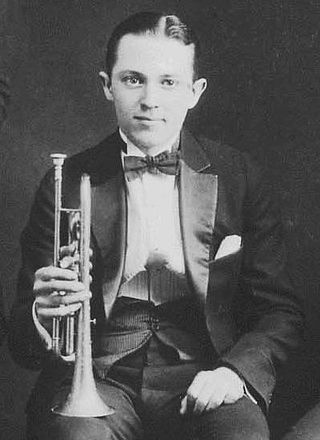
Leon Bismark "Bix" Beiderbecke was an American jazz cornetist, pianist and composer.

The Original Dixieland Jass Band (ODJB) was a Dixieland jazz band that made the first jazz recordings in early 1917. Their "Livery Stable Blues" became the first jazz record ever issued. The group composed and recorded many jazz standards, the most famous being "Tiger Rag". In late 1917, the spelling of the band's name was changed to Original Dixieland Jazz Band.
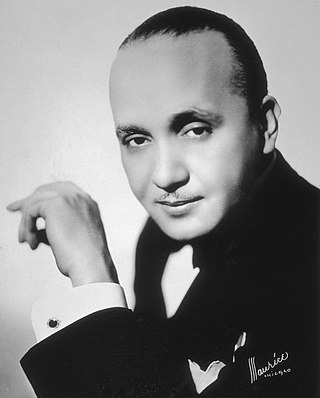
James Fletcher Hamilton Henderson was an American pianist, bandleader, arranger and composer, important in the development of big band jazz and swing music. He was one of the most prolific black musical arrangers and, along with Duke Ellington, is considered one of the most influential arrangers and bandleaders in jazz history. Henderson's influence was vast. He helped bridge the gap between the Dixieland and the swing eras. He was often known as "Smack" Henderson.
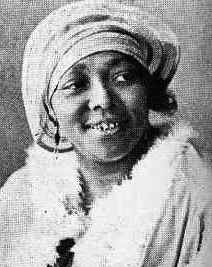
Lucille Bogan was an American classic female blues singer and songwriter, among the first to be recorded. She also recorded under the pseudonym Bessie Jackson. Music critic Ernest Borneman noted that Bogan was one of "the big three of the blues", along with Ma Rainey and Bessie Smith. Many of Bogan's songs have been recorded by later blues and jazz musicians.

Albert Edwin Condon was an American jazz banjoist, guitarist, and bandleader. A leading figure in Chicago jazz, he also played piano and sang. He also owned a self-named night club in New York City.
The Hot Five was Louis Armstrong's first jazz recording band led under his own name.

Robert Sage Wilber was an American jazz clarinetist, saxophonist, and band leader. Although his scope covers a wide range of jazz, Wilber was a dedicated advocate of classic styles, working throughout his career to present traditional jazz pieces in a contemporary manner. He played with many distinguished jazz leaders in the 1950s and 1960s, including Bobby Hackett, Benny Goodman, Sidney Bechet, Jack Teagarden and Eddie Condon. In the late 1960s, he was an original member of the World's Greatest Jazz Band, and in the early 70s of Soprano Summit, a band which gained wide attention. In the late 1970s, he formed the Bechet Legacy Band.
Dirty blues is a form of blues music that deals with socially taboo and obscene subjects, often referring to sexual acts and drug use. Because of the sometimes graphic subject matter, such music was often banned from radio and available only on jukeboxes. The style was most popular in the years before World War II, although it experienced a revival in the early 1950s.
Rosa Henderson was an American jazz and classic female blues singer and vaudeville entertainer of the Harlem Renaissance era.
"Squeeze Me" is a 1925 jazz standard composed by Fats Waller. It was based on an old blues song called "The Boy in the Boat". The lyrics were credited to publisher Clarence Williams, although Andy Razaf has claimed to have actually written the lyrics.

The period from the end of the First World War until the start of the Depression in 1929 is known as the "Jazz Age". Jazz had become popular music in America, although older generations considered the music immoral and threatening to cultural values. Dances such as the Charleston and the Black Bottom were very popular during the period, and jazz bands typically consisted of seven to twelve musicians. Important orchestras in New York were led by Fletcher Henderson, Paul Whiteman and Duke Ellington. Many New Orleans jazzmen had moved to Chicago during the late 1910s in search of employment; among others, the New Orleans Rhythm Kings, King Oliver's Creole Jazz Band and Jelly Roll Morton recorded in the city. However, Chicago's importance as a center of jazz music started to diminish toward the end of the 1920s in favor of New York.
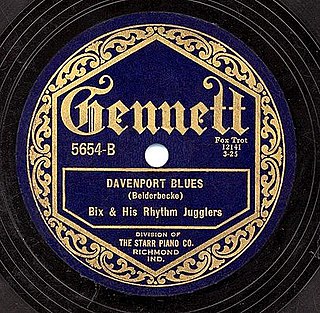
Davenport Blues is a 1925 song composed and recorded by Bix Beiderbecke and released as a Gennett 78. The song has become a jazz and pop standard.
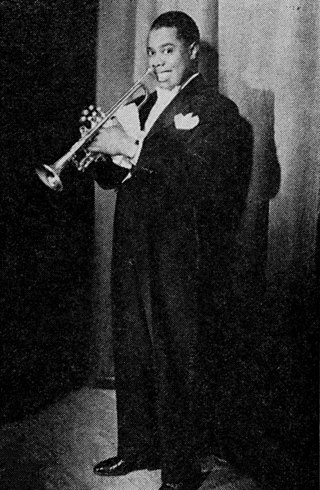
The Louis Armstrong Hot Five and Hot Seven Sessions were recorded between 1925 and 1928 by Louis Armstrong with his Hot Five and Hot Seven groups. According to the National Recording Registry, "Louis Armstrong was jazz's first great soloist and is among American music's most important and influential figures. These sessions, his solos in particular, set a standard musicians still strive to equal in their beauty and innovation." These recordings were added to the National Recording Registry in 2002, the first year of the institution's existence.

Hot Fives & Sevens is a 2000 box set collection of recordings made by American jazz trumpeter and singer Louis Armstrong with his Hot Five, Hot Seven, and other groups between 1925 and 1930. First released on JSP Records on 22 August 2000, the set was subsequently reissued on Definitive in 2001. A four-disc compilation, the set has received a "crown" as an author's pick in The Penguin Guide to Jazz and is also included in the book's "core collection" recommended for jazz fans. Allmusic concurs that it is "beyond indispensable", suggesting that "you can't have a Louis Armstrong collection without this historic set" or "any kind of respectable jazz collection" Alternatively, Ben Ratliff, writing in 2002, preferred Columbia's release The Complete Hot Five and Hot Seven Recordings.

The Smithsonian Collection of Classic Jazz is a six-LP box set released in 1973 by the Smithsonian Institution. Compiled by jazz critic, scholar, and historian Martin Williams, the album included tracks from over a dozen record labels spanning several decades and genres of American jazz, from ragtime and big band to post-bop and free jazz.
"Free Spirit" is a 1966 song by blues session player Hermon Hitson, which was mistakenly released as the title track of two albums of bootleg Jimi Hendrix recordings. The title track of both Free Spirit bootleg albums, and other songs recorded in the same sessions, contained contributions by Lonnie Youngblood and Lee Moses, but no verified content by Hendrix himself. A version of "House of the Rising Sun" is sometimes labelled as Hendrix, yet is Hermon Hitson.
Edmonia Henderson was an American classic female blues singer. She was active as a recording artist in the mid-1920s, recording at least 14 songs between 1924 and 1926. She later became an evangelist.
Fannie May Goosby also known as Fannie Mae Goosby was an American classic female blues singer, pianist and songwriter. Ten of her recordings were released between 1923 and 1928, one of which, "Grievous Blues", she recorded twice. Goosby was one of the first female blues musicians to record her own material. She also was one of the first two blues singers to be recorded in the Deep South, the other being the dirty blues singer Lucille Bogan.
References
- 1 2 3 4 Anderson, Gene Henry (July 31, 2007). The Original Hot Five Recordings of Louis Armstrong. Pendragon Press. p. 48. ISBN 9781576471203.
- ↑ "Spencer Walter Williams, Jr". Ragpiano.com. Retrieved 1 August 2019.
As cited in the side bar to the article
- 1 2 3 4 5 "----Joop's Musical Flowers: Shake That Thing (1925) / Georgia Grind (1926) / Georgia Crawl (1928) / It's Tight Like That (1928) / Bottle It Up And Go (1932) / Oil It Up And Go (1939) / Step It Up And Go (1940) / Shake It Up And Go (1942)". Jopiepopie.blogspot.com. July 14, 2014.
- ↑ "The Complete Hot Five and Hot Seven Recordings [Columbia/Legacy] - Louis Armstrong | Songs, Reviews, Credits". AllMusic . Retrieved 30 July 2019.
- ↑ Gene Henry Anderson; Michael J. Budds (2007). The Original Hot Five Recordings of Louis Armstrong. pp. 48–50. ISBN 9781576471203 . Retrieved 2016-05-07.
- ↑ "Dirty Blues | Music Highlights". AllMusic . Retrieved 30 July 2019.
- ↑ "Georgia Grind / Come Back Sweet Papa by Louis Armstrong and His Hot Five". Rateyourmusic.com. Retrieved 30 July 2019.
- ↑ Brothers, Thomas; Brothers, Thomas David (February 3, 2014). Louis Armstrong, Master of Modernism. W. W. Norton & Company. p. 209. ISBN 9780393065824.
- ↑ Brothers, Thomas (2014). Louis Armstrong: Master of Modernism. New York, NY: W.W. Norton & Company. p. 214. ISBN 978-0-393-06582-4.
- ↑ "Edmonia Henderson". Redhotjazz.com. Retrieved 1 August 2019.
- ↑ "Edmonia Henderson: Songs". AllMusic . Retrieved 30 July 2019.
- ↑ "Georgia Grind". Archive.org. July 30, 1926. Retrieved 30 July 2019.
- ↑ Tucker, Mark (July 30, 1995). Ellington: The Early Years . University of Illinois Press. p. 156.
Georgia Grind.
- ↑ Russell, Tony (1997). The Blues: From Robert Johnson to Robert Cray. Dubai: Carlton Books. p. 94. ISBN 1-85868-255-X.
- ↑ Calt, Stephen (October 1, 2010). Barrelhouse Words: A Blues Dialect Dictionary. University of Illinois Press. p. 100. ISBN 9780252090714.
- ↑ "Georgia Grind". Archive.org. April 20, 1939. Retrieved 30 July 2019.
- ↑ "Georgia Grind / Nix on Those Lush Heads by Blue Lu Barker". Rateyourmusic.com. Retrieved 30 July 2019.
- ↑ "Maria Muldaur's official web site". Mariamuldaur.com. Retrieved 9 September 2018.
- ↑ Morton, Brian. "Maria Muldaur: Don't You Feel My Leg – The Naughty Bawdy Blues of Blue Lu Barker". Jazzjournal.co.uk. Retrieved 30 July 2019.
- ↑ "78 Record: Eddie Condon - Georgia Grind (1941)". 45worlds.com.
- ↑ "Georgia Grind (Remastered) - Single by Eddie Condon and His Band". Music.apple.com. Retrieved 30 July 2019.
- ↑ "Chris Barber Record Covers: Chris Barber 1957-58". Chrisbarber.net. Retrieved 30 July 2019.
- ↑ "Illustrated NIXA Records discography". Wirz.de. Retrieved 30 July 2019.
- ↑ "Herman Hitson". Ponderosastomp.com. Retrieved 30 July 2019.
- ↑ "HERMON AND THE ROCKIN TONICS - BEEN SO LONG / GEORGIA GRIND - ROYAL アフロジュース│大阪心斎橋の中古レコード店、買い取り・トレードも随時受付中!". Afro-juice.com. Retrieved 30 July 2019.
- ↑ "Herman Hitson Discography - USA - 45cat". 45cat.com. Retrieved 30 July 2019.
- ↑ "Frank Traynor - Georgia Grind". 45cat.com. Retrieved 1 August 2019.
- ↑ A Life in Music: Chris Barber discography 1949–2001, Gerard Bielderman & Julian Purser, published by Gerard Bielderman, December 2001
- ↑ Riccardi, Ricky (June 12, 2007). "The Wonderful World of Louis Armstrong: Georgia Grind". Dippermouth.blogspot.com.